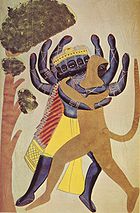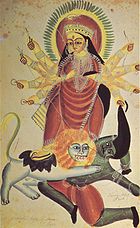
Kalighat painting
Encyclopedia

Bengal
Bengal is a historical and geographical region in the northeast region of the Indian Subcontinent at the apex of the Bay of Bengal. Today, it is mainly divided between the sovereign land of People's Republic of Bangladesh and the Indian state of West Bengal, although some regions of the previous...
, in the vicinity of Kalighat Kali Temple
Kalighat Kali Temple
Kalighat Kali Temple is a Hindu temple dedicated to the Hindu goddess Maa Kali. It is one of the 51 Shakti Peethas.Kalighat was a Ghat sacred to Kali on the old course of the Hooghly river in the city of Calcutta. The name Calcutta is said to have been derived from the word Kalighat. The river...
, Kalighat
Kalighat
Kalighat is a locality of Kolkata, India. One of the oldest neighborhoods in South Kolkata, Kalighat is also densely populated and vibrant -- with a rich history of cultural intermingling with the various foreign incursions into the area over time....
, Kolkata
Kolkata
Kolkata , formerly known as Calcutta, is the capital of the Indian state of West Bengal. Located on the east bank of the Hooghly River, it was the commercial capital of East India...
, India
India
India , officially the Republic of India , is a country in South Asia. It is the seventh-largest country by geographical area, the second-most populous country with over 1.2 billion people, and the most populous democracy in the world...
, and from being items of souvenir taken by the visitors to the Kali temple, the paintings over a period of time developed as a distinct school of Indian painting
Indian painting
Indian painting has a very long history, although the seasonally humid Indian climate was difficult for the long-term preservation of paintings and there are far fewer survivals than of other forms of Indian art. The earliest Indian paintings were the rock paintings of pre-historic times, the...
. From the depiction of Hindu
Hindu
Hindu refers to an identity associated with the philosophical, religious and cultural systems that are indigenous to the Indian subcontinent. As used in the Constitution of India, the word "Hindu" is also attributed to all persons professing any Indian religion...
gods, goddesses, and other mythological
Hindu mythology
Hindu religious literature is the large body of traditional narratives related to Hinduism, notably as contained in Sanskrit literature, such as the Sanskrit epics and the Puranas. As such, it is a subset of Nepali and Indian culture...
characters, the Kalighat paintings developed to reflect a variety of themes.
History
In the nineteenth century, the only school of painting that was flourishing in Bengal was the traditional art of scroll paintings that was popular in the rural areas. These paintings were done on cloth or patas. They depicted conventional images of gods and goddesses and scenes from epics like Tulsidas’ Rama charita manas. The artistes were villagers who travelled from place to place with their scroll paintings and sang the scenes from the epics depicted in the paintings during village gatherings and festivals. These artists, called patuas or ‘painters on cloth’ were said to be half Hindu and half Muslim and practised Islam.The British: Patrons of Indian Art
Meanwhile the British, having established themselves in the country politically started to evince interest in art, literature, and music. They set up institutions that imparted a European style of academic training to Indian artists. The Calcutta School of Art was one such school and attracted traditional artists–the patuas—to the city.Initially these artists were concentrated around the temple at Kalighat where there was a demand for religious art. Gradually, they started to learn from the newer techniques and discovered that these could help them increase their earnings. They started creating new forms of art and the Kalighat painting was born.

Oriental and Occidental Kalighat
The Kalighat School was an agreeable and unique blend of two different styles of painting—the Oriental and the Occidental—and steadily gained popularity. Among the deities that the Kalighat artists painted, the goddess Kali was a favorite. Images of Durga, Lakshmi, and Annapurna were also popular, especially during the Durga Puja festival. The artists also portrayed themes like Sita-Rama, Radha-Krishna and the exploits of Hanuman.Another theme depicted, dear to the Bengali ethos, was that of Chaitanya Mahaprabhu and his disciples. But the Kalighat artists did not restrict themselves to religious themes. Their paintings depicting different professions and costumes were also popular with the tourists. Even contemporary events like crime were the subject of many paintings. The artists also chose to portray secular themes and personalities and in the process played a role in the Independence movement. They painted heroic characters like Tipu Sultan and Rani Lakshmibai.
Capturing Quotidian Life
An important achievement of the Kalighat artistes was that they made simple paintings and drawings, which could easily be reproduced by lithography. Such prints were then hand coloured. This trend continued up to the early part of the twentieth century and these paintings ended up in museums and private collections. The charm of the Kalighat paintings lies in the fact that they captured the essence of daily life and they influence modern artistes like the late Jamini Roy even to this day.Further reading
- Kalighat Paintings ISBN 81-7436-135-9, by Aditi Nath Sarkar and Christine Mackay
- Kalighat Painting: Images from a Changing World (Ahmedabad and Middleton, NJ, 1999)
See also
- Indian paintingIndian paintingIndian painting has a very long history, although the seasonally humid Indian climate was difficult for the long-term preservation of paintings and there are far fewer survivals than of other forms of Indian art. The earliest Indian paintings were the rock paintings of pre-historic times, the...
- Madhubani paintingMadhubani painting]]Madhubani painting or Mithila painting is a style of Indian painting, practiced in the Mithila region of Bihar state, India and the adjoining parts of Terai in Nepal. In the present time the main artists include Smt Bharti Dayal ' Ganga devi ' Smt Bua Devi ,late Smt Jagdamba Devi,late Smt Sita...
- Mughal paintingMughal paintingMughal painting is a particular style of South Asian painting, generally confined to miniatures either as book illustrations or as single works to be kept in albums, which emerged from Persian miniature painting, with Indian Hindu, Jain, and Buddhist influences, and developed largely in the court...
- Rajput paintingRajput paintingRajput painting, also known as Rajasthani Painting, is a style of Indian painting, evolved and flourished during the 18th century in the royal courts of Rajputana, India, flowing from the style of Mughal painting, itself derived from the Persian miniature. Each Rajput kingdom evolved a distinct...
- Tarakeswar affairTarakeswar affairThe Tarakeswar affair refers to the public scandal in 19th century Calcutta – then the capital of the British Raj – resulting from the affair of the beautiful Elokeshi, wife of Nobin Chandra Banerjee, with the mahant – the Brahmin head priest – of...
: a common theme in the paintings
External links
- Kalighat Paintings of West Bengal
- Kalighat painting on Banglapedia
- Drawings and Paintings of Kalighat by Mukul Dey
- Showcase: Kalighat painting at National Gallery of Modern ArtNational Gallery of Modern ArtThe National Gallery of Modern Art is the leading Indian art gallery. The main museum at New Delhi was established on March 29, 1954 by the Government of India, with subsequent branches at Mumbai and Bangalore...
- The Painters of Kalighat: 19th Century Relics of a Once Flourishing Indian Folk Art Killed by Western Mass Production Methods by Mukul Dey

